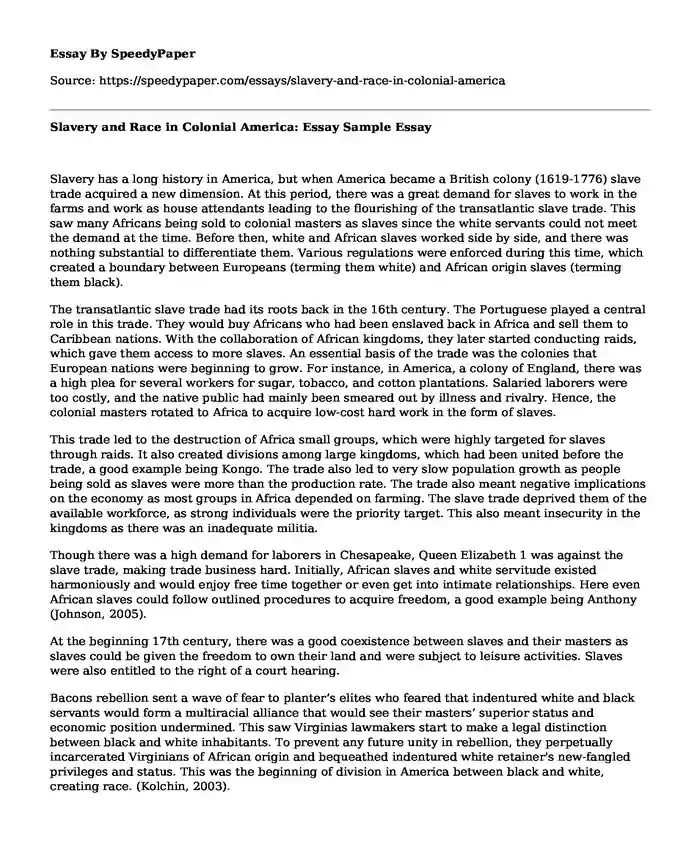
| Type of paper: | Essay |
| Categories: | Slavery American history |
| Pages: | 3 |
| Wordcount: | 674 words |
Slavery has a long history in America, but when America became a British colony (1619-1776) slave trade acquired a new dimension. At this period, there was a great demand for slaves to work in the farms and work as house attendants leading to the flourishing of the transatlantic slave trade. This saw many Africans being sold to colonial masters as slaves since the white servants could not meet the demand at the time. Before then, white and African slaves worked side by side, and there was nothing substantial to differentiate them. Various regulations were enforced during this time, which created a boundary between Europeans (terming them white) and African origin slaves (terming them black).
The transatlantic slave trade had its roots back in the 16th century. The Portuguese played a central role in this trade. They would buy Africans who had been enslaved back in Africa and sell them to Caribbean nations. With the collaboration of African kingdoms, they later started conducting raids, which gave them access to more slaves. An essential basis of the trade was the colonies that European nations were beginning to grow. For instance, in America, a colony of England, there was a high plea for several workers for sugar, tobacco, and cotton plantations. Salaried laborers were too costly, and the native public had mainly been smeared out by illness and rivalry. Hence, the colonial masters rotated to Africa to acquire low-cost hard work in the form of slaves.
This trade led to the destruction of Africa small groups, which were highly targeted for slaves through raids. It also created divisions among large kingdoms, which had been united before the trade, a good example being Kongo. The trade also led to very slow population growth as people being sold as slaves were more than the production rate. The trade also meant negative implications on the economy as most groups in Africa depended on farming. The slave trade deprived them of the available workforce, as strong individuals were the priority target. This also meant insecurity in the kingdoms as there was an inadequate militia.
Though there was a high demand for laborers in Chesapeake, Queen Elizabeth 1 was against the slave trade, making trade business hard. Initially, African slaves and white servitude existed harmoniously and would enjoy free time together or even get into intimate relationships. Here even African slaves could follow outlined procedures to acquire freedom, a good example being Anthony (Johnson, 2005).
At the beginning 17th century, there was a good coexistence between slaves and their masters as slaves could be given the freedom to own their land and were subject to leisure activities. Slaves were also entitled to the right of a court hearing.
Bacons rebellion sent a wave of fear to planter’s elites who feared that indentured white and black servants would form a multiracial alliance that would see their masters’ superior status and economic position undermined. This saw Virginias lawmakers start to make a legal distinction between black and white inhabitants. To prevent any future unity in rebellion, they perpetually incarcerated Virginians of African origin and bequeathed indentured white retainer's new-fangled privileges and status. This was the beginning of division in America between black and white, creating race. (Kolchin, 2003).
Based on the module, it’s crystal clear that slavery has adverse effects on any community. Apart from depriving society much-needed workforce, it subjects those traded as slaves to much suffering as they don't enjoy basic human rights. Slavery also creates long-term effects that may divide a nation; a good example is a creation of race in the 17th century, which still has its impact to date causing racial discrimination in America.
References
Wood, B. (2005). Slavery in Colonial America, 1619–1776. Rowman & Littlefield Publishers. https://www.edu/htmls/news/jimcrow/timeline/slavery
Lowance, M. I. (Ed.). (, 2003). A House Divided: The Antebellum Slavery Debates in America, 1776-1865. Princeton University Press. https://teachinghistory.org/history-content/ask-a-historian.
Kolchin, P. (2003). American Slavery: 1619-1877. Macmillan https://ena.orgSlavery_in_the_colonial_history_of_the_United_States
Cite this page
Slavery and Race in Colonial America: Essay Sample. (2023, Dec 30). Retrieved from https://speedypaper.com/essays/slavery-and-race-in-colonial-america
Request Removal
If you are the original author of this essay and no longer wish to have it published on the SpeedyPaper website, please click below to request its removal:
- Essay Example on Leadership
- Feminism Essay Sample: Years of Oppression
- Free Essay on Gender Roles in an American Culture
- Free Essay on a People's History of London: Women's Roles
- Free Paper on the Territorial Disputes on the South China Sea
- Essay Example on Women on Boards: Does Diversity Guarantee Better Performance?
- Marvelous Representation: Ms. Marvel's Impact on Diversity and Feminism in Contemporary Media
Popular categories




